
Today, I want to highlight an important initiative that amplifies the unheard, and often undocumented, stories of post-9/11 bigotry, harassment, and discrimination. Launched last week by the Sikh Coalition and co-sponsored by a host of organizations including the American Arab Anti-Discrimination Committee, South Asian Americans Leading Together (SAALT), Muslim Advocates, CAIR-California, and more, Unheard Voices of 9/11 is an interactive website that allows users to upload homemade videos of themselves sharing their experience(s) of post-9/11 injustice.
The site, which has been generating a lot of media attention in the last few days, states:
Members of the Muslim, Sikh, South Asian, and Arab American communities were twice victims of 9/11. Like all Americans we endured a horrific attack on our country by terrorists. We also continue to endure troubling attacks from fellow Americans in the form of hate crimes, employment discrimination, school bullying, profiling and other forms of discrimination.
These stories of discrimination have largely been unheard. This website is meant to give these unheard voices a voice. These are the stories of our community members unfiltered, in their own words. These are the unheard voices of 9/11.
As we are inundated with news about the tenth anniversary of 9/11 this week, it’s refreshing to see a powerful initiative like this one focusing on sharing our stories. It is a courageous, and often painful, act to tell one’s story. But it is necessary, both for the healing process of someone who has experienced injustice, and also for everyone who hears that story, reflects upon it, learns from it, and is moved by it.
We have many songs that remind us of Shaheeds; we acknowledge them in our Ardas; and they are an integral part of our Sikh history. It is a powerful experience to hear how an integral concept in Sikhi manifests in other communities. Specifically the Muslim community, which also adheres to a concept of Shaheedi.
Often times in the media, the concept of Shaheedi has been presented as a form of “brainwashing” done by religious and political leaders to condone terrorism and violence for their own self-interests. However, a recent NPR report highlights how two devote Muslim men from America became Shaheeds out of their own strong will to bring justice back to their home country of Libya.
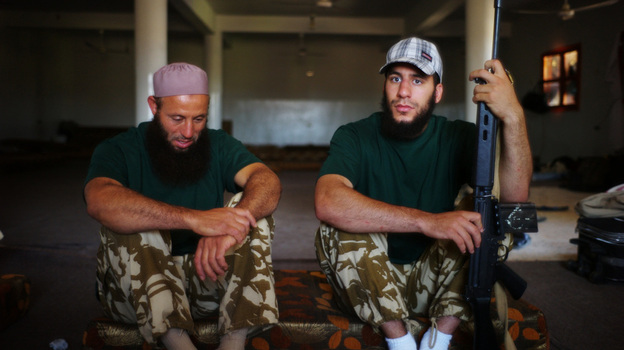
Mabruk Eshnuk (left) and his son Malik (right) left their home in Pittsburgh to volunteer and fight with rebels in western Libya's Nafusa Mountains.
A father and son left their home in Pittsburgh, Pennsylvania (USA) to participate in the Libyan revolution. Mabruk Eshnuk and his 21-year old middle son, Malik Eshnuk, died fighting the forces loyal to Moammar Gadhafi in western Libya.
Mabruk, a devoute Muslim had immigrated from Libya as a teenager. He taught Islam to convicts in the Pennsylvania state penitentiary system. In 2006, he housed the family of a young Iraqi boy who was getting lifesaving treatment in the United States. He said, “Everything that we do and work and help, it’s based on the Quran.” Outraged over what was happening in Libya, he took his middle son to fight in the Western mountains of Libya.
As mentioned last month, New York City-based Vishavjit Singh released his first “Sikhtoons” book this Spring. Entitled My Headcovering is Downright Sikh: An Illustrated Intro to Turbans, the book “uses a collection of cartoons from Sikhtoons.com to create a visual narrative to dispel the mysteries of the Sikh turban. Featuring Fauja Singh, Waris Ahluwalia and many other Sikhs from all walks of life this visual journey is a turbanful introduction to Sikhs.”
The book features 30 cartoons and can be ordered online in the US, Canada, and UK for $10.
Though I have not seen the book myself yet, it has the endorsement of Sikh scholar IJ Singh, who states:
Vishavjit Singh’s topic is serious, his touch light, but not comedic. The sense of the absurd is critically important to the cartoonist. That, too, will emerge, I am sure, for I see their seeds in his work. I believe that the lightest matters deserve a serious undertone and the most heavyweight issues need some levity, even comedic treatment sometimes, lest the burden becomes too heavy to carry.
Congratulations to Vishavjit on this accomplishment. As misconceptions and stereotypes about Sikhs continue to persist in the mainstream media and general public, I hope Vishavjit’s creative cartoon interventions reach a much wider audience through this book.
This past Sunday, violence erupted in an ongoing conflict between rival factions at the Gurdwara Baba Makhan Shah Lobana in Richmond Hill, Queens, the heart of New York’s Sikh community. Large kirpans as well as cricket bats and balls were used in the fighting. Dozens of community members and “leaders” were injured, and seven men were arrested.
Sunday was the escalation of an ongoing power struggle between leadership factions in the Richmond Hill Sikh community. There have been many violent incidents in the last several months at this Gurdwara (which itself was born out a violent conflict at the original Richmond Hill Gurdwara, the Sikh Cultural Society), resulting in a regular police presence there.
I don’t claim to understand the reasons behind the conflict at this Gurdwara, nor do I really care. This type of behavior is inexcusable and unjustifiable. And it is far too common in our community, and in particular, in our houses of worship. Much deeper discussions and interventions are needed about violence in our Gurdwaras than I will go into here.
That being said, as a follow up to Navdeep’s post about Sikhs and the Media yesterday, I want to focus on the news coverage of this incident in Richmond Hill. The New York Post* (one of NYC’s biggest newspapers with over 525,000 print copies sold daily) broke the story with this headline on Monday: Queens Turban Warfare: Sword-Wielding Sikhs attack praying rivals.
Our mothers and grandmothers would be proud. If we take a moment to pause, we’ll see the amazing mobilization that is occurring in the diaspora around Sikh women’s issues, particularly by youth. I’m not quite sure if it is a legit rise in websites or events or whether we are simply paying more attention to the topic. Regardless, it is clear that there are now more forums and platforms for discussion cultivating the need for women (and men!) to come together and address issues affecting Half the Sky. This post will give a round-up of some amazing work that is happening in our community, bringing together our qaum to discuss important issues affecting Sikh women.
 {Kaurista} It is clear that Sikh women, like all women around the world, value an open space to discuss issues that directly impact us. Whether it is conversations about clothes, hair, identity or our activism – there needs to exist a space that is catered to providing Sikh girls and women with a sense of unity. This type of comraderie cannot be understated – it impacts an individual’s self esteem and confidence in a substantial way. With the launch of Kaurista.com and the immediate posting of the link all over Facebook, it is hard not to notice how much support there is for this type of forum. Kaurista provides conversations on six different topics including, Lifestyle, Style & Beauty, Family, Inspiration and Health & Wellness. One of my favourite sections of the website is “Ask Kaurista” where questions related to wanting to marry a sardar, going to prom, or overcoming alcohol abuse are answered. The site is not only aimed at Sikh girls. In fact, it actively includes Sikh men in discussions – and perhaps the hope is that through these types of discussions, Sikh men will value how truly dynamic Sikh women are!
{Kaurista} It is clear that Sikh women, like all women around the world, value an open space to discuss issues that directly impact us. Whether it is conversations about clothes, hair, identity or our activism – there needs to exist a space that is catered to providing Sikh girls and women with a sense of unity. This type of comraderie cannot be understated – it impacts an individual’s self esteem and confidence in a substantial way. With the launch of Kaurista.com and the immediate posting of the link all over Facebook, it is hard not to notice how much support there is for this type of forum. Kaurista provides conversations on six different topics including, Lifestyle, Style & Beauty, Family, Inspiration and Health & Wellness. One of my favourite sections of the website is “Ask Kaurista” where questions related to wanting to marry a sardar, going to prom, or overcoming alcohol abuse are answered. The site is not only aimed at Sikh girls. In fact, it actively includes Sikh men in discussions – and perhaps the hope is that through these types of discussions, Sikh men will value how truly dynamic Sikh women are!
{HERSTORY}
Conversations about hair are often emotional for Sikhs – and therefore they are conversations which we tend to avoid. For many Sikhs, it is a constant struggle to explain the historical significance of keeping our hair and/or wearing a turban while other Sikhs will argue that simply keeping your hair or wearing a turban by no means makes you a good Sikh. While that may be true, being able to have conversations about hair is an incredibly important and necessary dialogue for us to participate in. Many Sikhs in the diaspora have struggled to maintain their identity, while Sikhs in Panjab are struggling to be western. It’s such an interesting juxtaposition and anybody who has visited Panjab recently will see the dwindling number of Sikh boys choosing to wear turbans. In an effort to explore this issue, a fascinating documentary film – Roots of Love – by award winning filmmaker Harjant Gill is being released this Spring.
Told through the stories of six different men ranging in age from fourteen to eighty-six, Roots of Love documents the changing significance of hair and the turban among Sikhs in India. We see younger Sikh men abandoning their hair and turban to follow the current fashion trends, while the older generation struggles to retain the visible symbols of their religious identity. The choice of cutting one’s hair is one that not only concerns the individual and his family, but an entire community. [link]
I was given the opportunity to watch the entire documentary – I highly recommend the film and was drawn to its excellent cinematography. You can watch the trailer below and after the jump, read my interview with Director, Harjant Gill. Then, think about how hair plays a significant role in your life, if at all?
I always get nervous in October because, although I love Halloween and all the imagination and candy involved in its celebration, it scares me a little bit. But not because of all too realistic vampire costumes or haunted houses.
 This is what really scares me:
This is what really scares me:
Every year, at least one person comments on my supposed “costume” when I’m not dressed up. Is wearing a turban in New York City still so foreign to people that it looks like a Halloween costume? Or does the holiday gives people an extra excuse to flaunt their racism? Two years ago, I was at a party (not dressed up) the week before Halloween, and a guy came up to me and asked me where my flying carpet was. For real. One of the first times I remember this sort of thing happening was an October afternoon when I was 13 or 14, hanging out at the mall in the suburbs of Phoenix, AZ with a good (Sikh) friend. An adult stranger said to us, laughing, “Nice condom head costumes guys!”
Now, on to the actual costumes people wear (and that stores often sell) with intention. Last year’s most notorious was the Illegal Alien costume (pictured here), sold at chains such as Toys R Us, Walgreen’s, Target, and more. After an uproar from immigrant rights groups, many stores pulled the costume off the shelves late in the season. But fear not, you can still get some laughs, as the product’s description states, this year as it is still available online and at K-Mart.
I just came across this great campaign to urge the American public to stop calling immigrants “illegals.” Brought to us by the racial justice media organization Colorlines, the “Drop the I-Word” Campaign website states, “The I-Word creates an environment of hate by exploiting racial fear and economic anxiety, creating an easy scapegoat for complex issues, and OK-ing violence against those labeled with the word.”

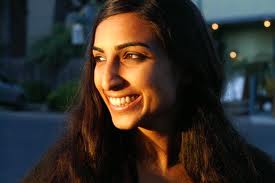
I write this as it is the truth as I see it. Not out of spite or rancor, but out of a desire to caution others and promote the path of critical self-reflection. I write about peddlers of self-promotion.
The topic is hardly new. In fact, Jodha beat me to the punch years ago, but here is my own contribution to the list.
Valarie Kaur. We have all seen her movie…..at least a half a dozen times (coming again and again and again and again to a Sikh event near you). We have all heard her speak….my head still reels from the vacuousness. We have read her writings….still hoping for a point beyond her ceaseless self-promotion. We have all heard her heart-wrenching, tormented, and soul-searching story as she climbed out of the pits of hell, all for being named…Valarie (shudder!).
As the debate over the so-called “Ground Zero Mosque” wages on in the media with plenty of misinformation and a whole lot of fear-mongering, we finally get some worthwhile news from The Daily Show on the subject.
| The Parent Company Trap | |
The Washington Times printed this photo of Elena Kagan yesterday with the caption “Elena Kagan and Sharia”:
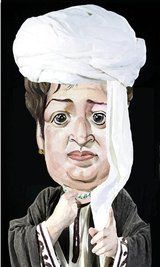
The fear continues.
By now, everyone should have heard of Glee – a musical comedy-drama television series focusing on a high-school glee club. A glee club is a musical group which traditionally specializes in the singing of short songs. Before writing this blog post, i didn’t quite know how big this phenomenon was… but apparently it’s big and there is a large following of gleeks and gleemania.
A young Sikh girl by the name of Raveena is hoping to audition and land a role on the show. There is a Facebook page dedicated to helping “Raveena get on the show”.
I am auditioning for this TV show called Glee, I trust that you have heard of it and I need your help. As a Sikh, its been really hard for me to land roles in a more professional environment because there are very few roles available for Indians. With the nationwide casting call for Glee, I can hopefully show everyone what I’ve got and get a call back for a show that is looking for people who don’t quite fit the mold.
Here on TLH, we love to highlight Sikhs who are pursuing their passions. Watch Raveena’s video and if you like it – take a few moments to rate/comment on her video so that she has a chance to audition for the show.
 The Ravi Foundation recently released PunjabiKosh – the first full-featured, mobile Punjabi-English and English-Punjabi Dictionary. Designed for iPhones and iPods, this Punjabi dictionary is the first of its kind created for this platform. The app is currently priced at $6.99.
The Ravi Foundation recently released PunjabiKosh – the first full-featured, mobile Punjabi-English and English-Punjabi Dictionary. Designed for iPhones and iPods, this Punjabi dictionary is the first of its kind created for this platform. The app is currently priced at $6.99.
The app provides for a clean, intuitive and easy-to-use interface that’s both attractive and clean. Features include:
- 30,000+ Word Dictionary
- Includes Common Punjabi Phrases and Idioms
- Full Gurmukhi Unicode Native-Keyboard
- English & Punjabi Search Capabilities
- Reverse-Definition English Search
- Vowel Fuzzy-Search
- Gurmukhi & Shahmukhi Transliteration
- Part-of-Speech
100% of the profits made from the sales of the app will be donated to fund a project with The Association for the Welfare of the Handicapped. While the group is still attempting to fix some coding issues (the iPhone does not fully support the Gurmukhi unicode font) this application seems to be a great first step.
Guest blogged by Harbakhsh Grewal
At the start of this year BBC 1, Britain’s premiere tv channel, highlighted the importance of 1984 to the Sikh psyche with a film documenting the personal journey of a British Sikh woman, journalist Sonia Deol. The reaction from many Sikhs has been hostile and vocal. Did the programme insult the faith, demonise its leaders and miss a massive opportunity to set the record straight as some have claimed? And even if it did, does the presenter deserve the vitriolic response resulting in her deleting her facebook page to avoid any more abuse?
Whatever the rights and wrongs of the programme, the response to it shows the level of concern still in the community to the tragic and horrific events of 1984. However some of the criticism has been purely personal and deeply unpleasant and does nothing to redress the balance or aid the causes that those who are angry care about.
To discuss the programme in any detail requires much deliberation. And that in a sense is why the programme should be applauded: the issues covered were of such enormity and complexity the programme makers should be congratulated for daring to cover them at all in the first place – and to try and do so within an hour slot is a task of great difficulty.
And the fact that many younger Sikhs, as well as the wider non-Sikh public more generally, have discovered a whole chapter of their own community’s history in some depth and breadth I think shows that the BBC has provided a much needed service.
Those who criticise on specific issues such as the portrayal of Bhindranwale have their own points to make. But they seem at times illogical.
Over the past few months, we have come across various articles in the media depicting the state of affairs for students of Indian origin living in Australia. Attacks against Indians (allegedly racially motivated) and, what was perceived to be, a poor response by the police and leaders sparked protests in both Australia and India. Widespread media coverage in India has been especially critical of Australia’s handling of this violence. On the other hand, however, the Indian media’s coverage has been likened to hysteria by many in Australia. Many are saying that the Indian media has done more harm than good in their coverage of the events, and in doing so, have shadowed the real problems faced by students in Australia.
So what exactly is going on? A few days ago we received an email from a TLH reader in Australia who wanted to share his perspective on the situation:
I am a year 12 student from Australia about to go into university and I would just like to express some opnions which I hope you could take to the readers of The Langer Hall. Recently there has been much uproar in the Indian media and community about these so-called racist attacks on Indian students in Australia. It really pained me to hear how such events could occur in what has developed to be one of the most multicultural countries in the world. Having just finished school I can say that the range of cultures and backgrounds which I have been exposed to…has been awesome. In my fifteen years as a turbaned boy I have not once felt like this country holds any form of racist ideas against me. My father has been a turbaned bus driver, and now a train driver for many years and he expresses similar ideas to me… Just recently the news begins to appear through investigations by Australian Police that many of these attacks on Indian students..were in fact carried out by other Indian students. I am not saying that all the attacks that occur…are by Indians…but i am raising the point that Australia is not as bad as many people make it seem. I see in Indian newspapers everyday that there was some attack on an Indian and they request Indians to stop going to Australia. Yet not one paper made mention of the fact that it was Indian students who had been arrested for the murders. Well I suppose that is expected in India… [-KS]
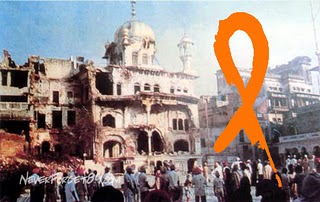 Guestblogged by Joo Kay Singh
Guestblogged by Joo Kay Singh
I’ve just spent the past hour watching 1984: A Sikh Story on BBC1 in the UK, and came away mildly disappointed, but not altogether surprised.
The documentary was framed as a “personal journey” for the presenter, Sonia Deol, to “unravel the events of 1984, an iconic year for Sikhs”, and informs us that “the bloody aftermath that followed [of Indira Gandhi’s assassination] so shocks Sonia that she is forced to reappraise the depth of her commitment to her faith”
For the first part of the program, we were served up with interviews mainly with Mark Tully and K.S. Brar who sounded like they were both regurgitating paragraphs from their respective books on the subject on the background to the Invasion. Sant Jarnail Singh was given the usual ‘congress stooge turned bad’ treatment by both, and the Darbar Sahib invasion covered without a hint of investigative journalism. Sonia failed to enquire why 37 other gurdwaras were attacked on the same day, if as per Tully and Brar’s insistence, Indira Gandhi was merely interested in Sant Bhindrawale. She similarly fails to question either of the men on the timing of the attack, on why the entire state of Panjab was placed under curfew, the expulsion of all foreign media, or the killings of pilgrims by the Army.
For our TLH readers in the UK – this documentary is premiering tonight on BBC One at 10:55pm.
Just over 25 years ago, the storming of The Golden Temple, the most sacred of Sikh shrines, by the Indian Army led to protests around the world. Sonia Deol embarks on a personal journey to unravel the events of 1984, an iconic year for Sikhs. It culminated in thousands of deaths including the assassination of the Prime Minister, Mrs Indira Gandhi. The bloody aftermath that followed so shocks Sonia that she is forced to reappraise the depth of her commitment to her faith. [link]
As with every retelling of this part of history, the question is whether the documentary will be controversial. One article suggests the BBC may be stirring up a “hornet’s nest of controversy,”
[It] is likely to prove controversial with some Sikh groups because of its portrayal of the militant Sikh preacher Sant Jarnail Singh Bhindranwale. It is also likely to draw the ire of the Indian government for its story on how it reacted following the assassination of Indira Gandhi. [link]
Nevertheless, this is an event that has often been ignored in international media – so i’m sure many in the community will welcome the coverage. If any of TLH readers do happen to catch the show tonight, please share your thoughts!
Last weekend I attended the Sikh Lens Sikh Art and Film Festival in Hollywood. I have attended film festivals all over North America and strongly believe in their need and presence in our community. Many times, however, the events get overshadowed by the glitz and glamour – the red carpet, the photographers, the eccentric outfits… I was therefore grateful that my experience at the Sikh Arts and Film Festival was a fulfilling one – I left knowing that Sikh Arts and Films bring value to our community and need to be supported. In addition, I felt the organizers made a special effort to keep the event focused on the directors, artists, musicians, actors, authors and organizations who were present. They recognized the fact that we are all in this together. Sikh Arts and Films are only beginning to be acknowledged, there is so much potential and growth that will still occur. However, this isn’t going to magically happen overnight, and it most definitely won’t happen without the community’s support.
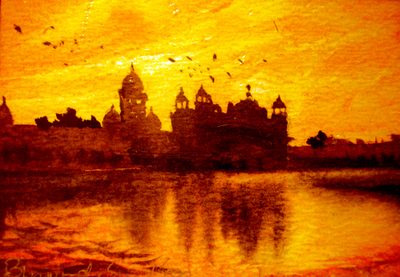 I was recently told that Sikhs in the UK spend 7 times more on license plates than they do on books (yes, 7 times!). While I’m not sure of the statistic in the US, the point is clear – perhaps we’re not investing in the right places? I think as a community we have begun to establish the need to support non-profit organizations that are working to address human rights, legal, education and activism issues (although we still have a long way to go to enhance our support). However, what goes hand in hand with this is the support and advancement of Sikh Art and Media. Without a doubt, events such as Sikh Lens are helping to pave the path – however, we as a community need to ask ourselves why we are so hesitant to spend money on independent films, children’s books, on historical references and on paintings. When I think about other immigrant communities, I notice that their advancement as a community comes from their support of one another. Whether we like to admit it or not, our community is extremely frugal and competitive with each other, and unless we start to move away from those stereotypes – we will not be creating a better world for our children.
I was recently told that Sikhs in the UK spend 7 times more on license plates than they do on books (yes, 7 times!). While I’m not sure of the statistic in the US, the point is clear – perhaps we’re not investing in the right places? I think as a community we have begun to establish the need to support non-profit organizations that are working to address human rights, legal, education and activism issues (although we still have a long way to go to enhance our support). However, what goes hand in hand with this is the support and advancement of Sikh Art and Media. Without a doubt, events such as Sikh Lens are helping to pave the path – however, we as a community need to ask ourselves why we are so hesitant to spend money on independent films, children’s books, on historical references and on paintings. When I think about other immigrant communities, I notice that their advancement as a community comes from their support of one another. Whether we like to admit it or not, our community is extremely frugal and competitive with each other, and unless we start to move away from those stereotypes – we will not be creating a better world for our children.
 This weekend Sikhlens will be presenting its annual Sikh Art and Film Festival 2009. The film festival showcases the best in Sikh movie-making talents from around the globe. It also presents a forum for aspiring Sikh artists to also come and display their burgeoning talents. A few book launches are planned with a particular emphasis on children’s books. Authors of A Lion’s Mane and The Royal Falcon are planned to be in attendance to do a live reading.
This weekend Sikhlens will be presenting its annual Sikh Art and Film Festival 2009. The film festival showcases the best in Sikh movie-making talents from around the globe. It also presents a forum for aspiring Sikh artists to also come and display their burgeoning talents. A few book launches are planned with a particular emphasis on children’s books. Authors of A Lion’s Mane and The Royal Falcon are planned to be in attendance to do a live reading.
The inaugural Sikh Art and Film Festival will be held at the historic Egyptian Theatre in Hollywood, CA on November 13-15th.
In previous articles on The Langar Hall, I have written about how certain Sikh-film haters groan in jealousy and spew hatred, about the Sikhs’ taking advantage of new forms of media. Such efforts in the community should be encouraged and more platforms created.
The weekend features a number of different clusters, highlighting issues on the youth, creative Sikhs, short films, feature films, and even Remembering 1984. The Remembering 1984 cluster on Sunday afternoon will be co-hosted with the Jakara Movement in conjunction with it’s Visions of Truth film series.
So whether you come for the entire weekend, make it out to just one cluster (at $15 pre-sale, you won’t find a better price), or at least to Sunday’s mela, check the schedule, check out the films, and make sure you come out and support Sikh arts! We’ll be in attendance and will post on our experience after the event.
The role of Sikh women often remembered in 1984 is that of victim. Yes women were raped, killed, and left to care for their families when their male relatives were kidnapped and killed. However, the strength and perseverance to move forward without justice is often glossed over. I find it powerful to hear Sikh women’s stories of “moving on” while continuing to speak out against the horrific injustices of 1984. Often there is talk about how Sikhs have been in a state of “victimhood” for the past 25 years. I believe the stories of the women below show how some Sikhs have empowered themselves to move forward with their daily lives in the past 25 years while living with the pain and not giving up on the demand for justice. This is agency and not victimhood.
Yes institutions, memorials, and marches show how Sikhs are attempting to move forward as a community; however, these women have done something that is far more difficult-picking up the pieces of their lives in the midst of devastation and mending them together as best as they could for themselves, their families, and their community. These women are inspirational and their lives for the past 25 years show why.
Watch the videos below in Hindi to hear their stories (hat tip: Mallika). One of the most powerful reflections of 1984 I have seen.



